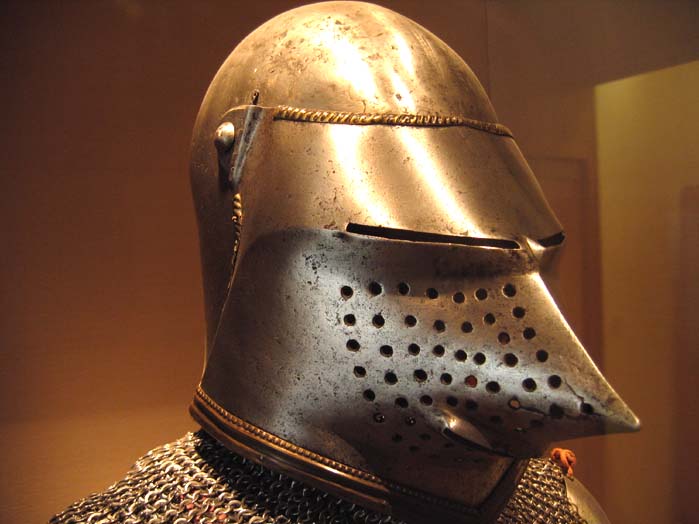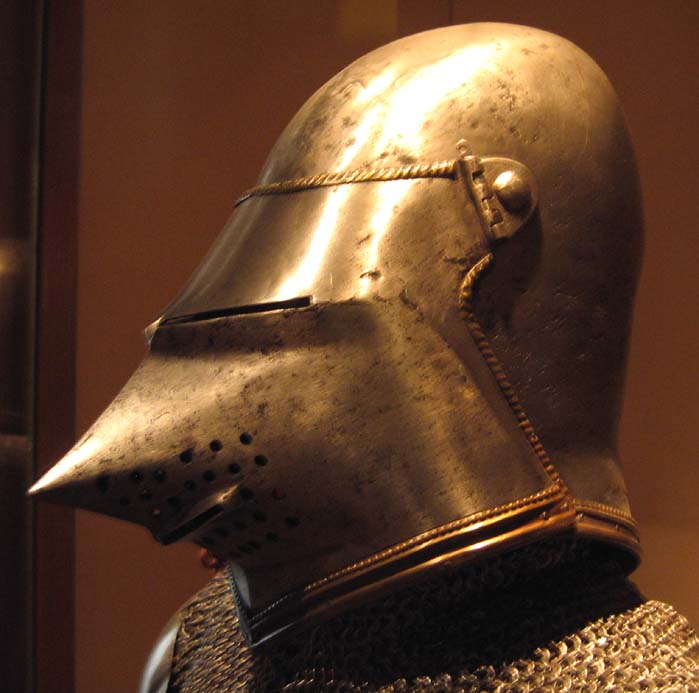Hi, this is a great site! Does anyone know where there are pictures of the bascinet from the Met the one with the Burgundy Brigandine, page 55 in Arms and Armour Through The Ages by Helmut Nickel? It doesn't look as though there is any way of affixing an Aventail to this Bascinet and also looks to go down a long way at the back, just like to clear up my curiosity on this one.
Also generally interested in armour around 1390 as I am starting to make a suit and having made some mail in the past I am not looking forward to making a whole load for this project, I am sure there must have been some kind of bevor around but can't seem to find anything to go with a bascinet?
Regards Lawrence
| Lawrence Parramore wrote: |
| Hi, this is a great site! Does anyone know where there are pictures of the bascinet from the Met the one with the Burgundy Brigandine, page 55 in Arms and Armour Through The Ages by Helmut Nickel? It doesn't look as though there is any way of affixing an Aventail to this Bascinet and also looks to go down a long way at the back, just like to clear up my curiosity on this one.
Also generally interested in armour around 1390 as I am starting to make a suit and having made some mail in the past I am not looking forward to making a whole load for this project, I am sure there must have been some kind of bevor around but can't seem to find anything to go with a bascinet? Regards Lawrence |
Hi Lawrence,
There's no way to attach an aventail to that bascinet because it rusted out at the line of the holes for the vervelles, so Bashford Dean (who was, by profession, a paleontologist, not an armor expert) had someone weld a new skirt onto it to make it match his vision of the piece. That entire harness is a kludge pieced together by Dean based on almost complete ignorance; the fauld on the globose-chested coat of plates, for example, is ludicrously wrong and was kludged together from random plates that Dean hacked out of other pieces. The museum (well, the people in the museum who care about such things) are highly embarrassed by the whole harness and only keep it because it's the closest thing they have to an early harness and because the public expects it. You notice, however, that it's jammed into a wall so you can't see the back: there's a reason for that--that back is even more wildly innaccurate than the front.
So, the short answer is, you can't use this as a good example, and no, it wouldn't have had a bevor, etc. It was a nice, normal, late-14th-century bascinet until Dean abused the poor thing.
Thanks, well that is a bit of info that I didn't know before. Hmm there were bevor type things a hundred years before and thirty or so years later, wonder what happened to them or were they hidden by mail or cloth aventails between times?
So now I really need to do some research on mail for aventails, looks like small links and I guess they would have been a lot sturdier, as after six hundred plus years they must have shead a pile of rust?
Best Lawrence
So now I really need to do some research on mail for aventails, looks like small links and I guess they would have been a lot sturdier, as after six hundred plus years they must have shead a pile of rust?
Best Lawrence
Here are two pictures from my trip earlier this year.
 Attachment: 49.76 KB
Attachment: 49.76 KB

 Attachment: 54.85 KB
Attachment: 54.85 KB



What a strange skull on that bascinet. I am not sure I have ever seen this one before. THe visor looks italian to me but hte skull is so interesting. perhaps a link between the stage where great bascinets have more rounded than pointed tops.
RPM
RPM
I'm wondering if the Met have ever thought about a more accurate restoration of that armour, or is now too late? Has too much damage been done to it by the previous "restoration"?
Thanks you guys, so I guess where the back suddenly shoots out is where the extension was put on, if that wasn't there it would look like a normal-ish Bascinet but for the more rounded dome? And the de-lamination on the visor may be evidence of a fire weld, I will be trying to do this with firewelding this week so fingers crossed, I was going to fire weld the back of the helm because it is straight-ish and seemed the obvious choice, but having looked at as many of these as I can, the weld seems to have been done at the front which really does take the lions share out of the forming process!
Anybody seen any pictures of these bascinets with anything other than an aventail?
Regards Lawrence
Anybody seen any pictures of these bascinets with anything other than an aventail?
Regards Lawrence
Hello, you mentioned the body armour being inaccurate, which is the piece presented with this bacinet. I have fount an article, though in German, it has some detailed photos of the original piece and a reconstruction. In this text it is believed to be a real thing. So whats so utterly wrong with this?
http://www.company-elefant.com/deutsch/biblio...antine.pdf
http://www.company-elefant.com/deutsch/biblio...antine.pdf
Last edited by Felix R. on Sun 02 Sep, 2007 3:06 am; edited 1 time in total
Hi Felix, would it be possible to show this article or email me a copy?
Regards Lawrence
Regards Lawrence
Hi Lawrence, just look at the link I added. ;)
:eek: how did I miss that !! :lol:
Thanks !
Thanks !
| Felix R. wrote: |
| Hello, you mentioned the body armour being inaccurate, which is the piece presented with this bacinet. I have fount an article, though in German, it has some detailed photos of the original piece and a reconstruction. In this text it is believed to be a real thing. So whats so utterly wrong with this?
http://www.company-elefant.com/deutsch/biblio...antine.pdf |
Thanks for posting that link. :)
Assuming the reconstruction in the German article is accurate, then the fauld is completely different to the way it is reconstructed in the Metropolitan. I'm guessing though that the armour in the Met had many missing pieces, so a complete restoration to its original appearence would be impossible anyway.
| Felix R. wrote: |
| Hello, you mentioned the body armour being inaccurate, which is the piece presented with this bacinet. I have fount an article, though in German, it has some detailed photos of the original piece and a reconstruction. In this text it is believed to be a real thing. So whats so utterly wrong with this?
http://www.company-elefant.com/deutsch/biblio...antine.pdf |
That reconstruction is an attempt to make a globose-breasted coat of plates (often called a "corrazina" on the internet, but as far as I know that term has no historical validity) as the one at the Met should have been made. If you look at the original on the first page you'll see that the fauld is composed of vertical plates, which would have made it impossible to bend over while wearing this piece. It's supposed to have a hoop-style fauld as the reconstruction does. And while you can't see it, the back of the original is composed of a myriad of small plates all stuck together in a sort of Frankensteinian reconstruction.
Incidentally, if you look at it carefully you'll notice that the reconstruction is also flawed: The lung plates don't have nearly enough curvature when compared with the original (which are correct). Many reenactors do that because the deeply raised plates get in the way of the inauthentic fighting techniques they use, and since the reason for the shape--deflecting sharp weapons--doesn't apply, they don't have any incentive to make the piece correctly.
Page 1 of 1
You cannot post new topics in this forumYou cannot reply to topics in this forum
You cannot edit your posts in this forum
You cannot delete your posts in this forum
You cannot vote in polls in this forum
You cannot attach files in this forum
You can download files in this forum
All contents © Copyright 2003-2006 myArmoury.com — All rights reserved
Discussion forums powered by phpBB © The phpBB Group
Switch to the Full-featured Version of the forum
Discussion forums powered by phpBB © The phpBB Group
Switch to the Full-featured Version of the forum